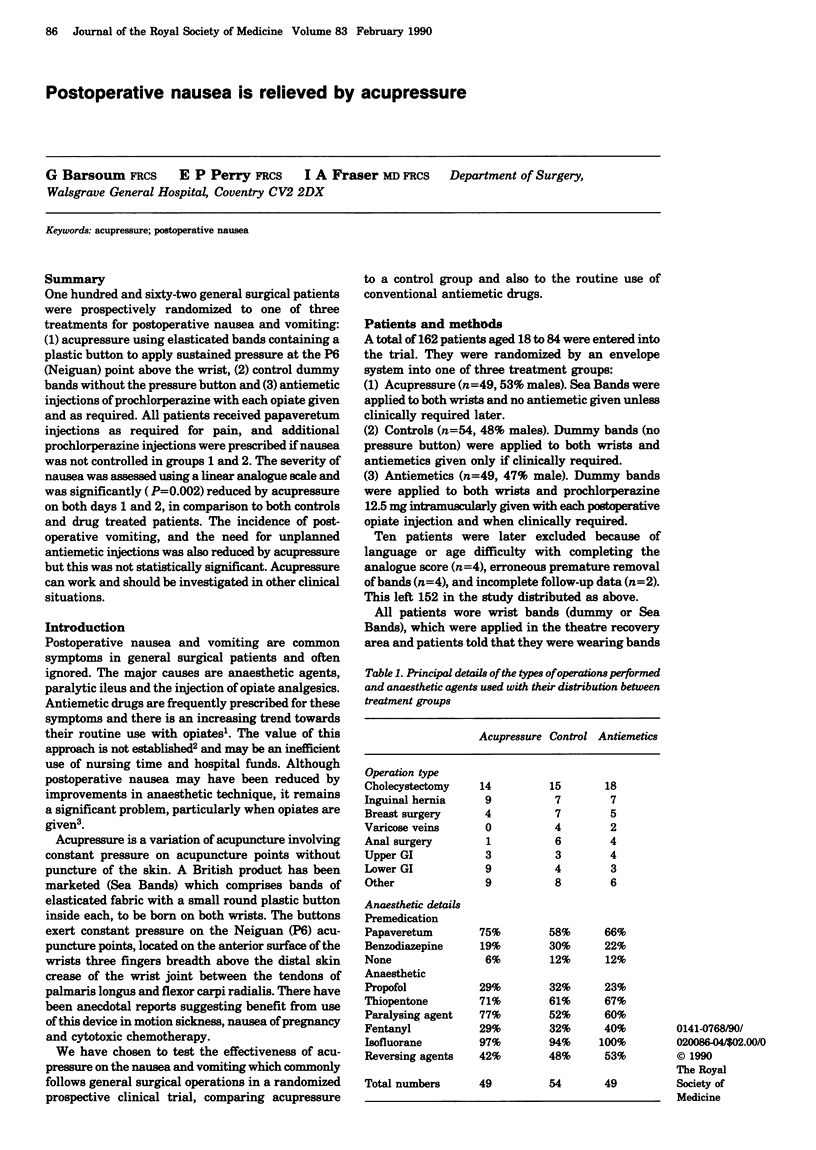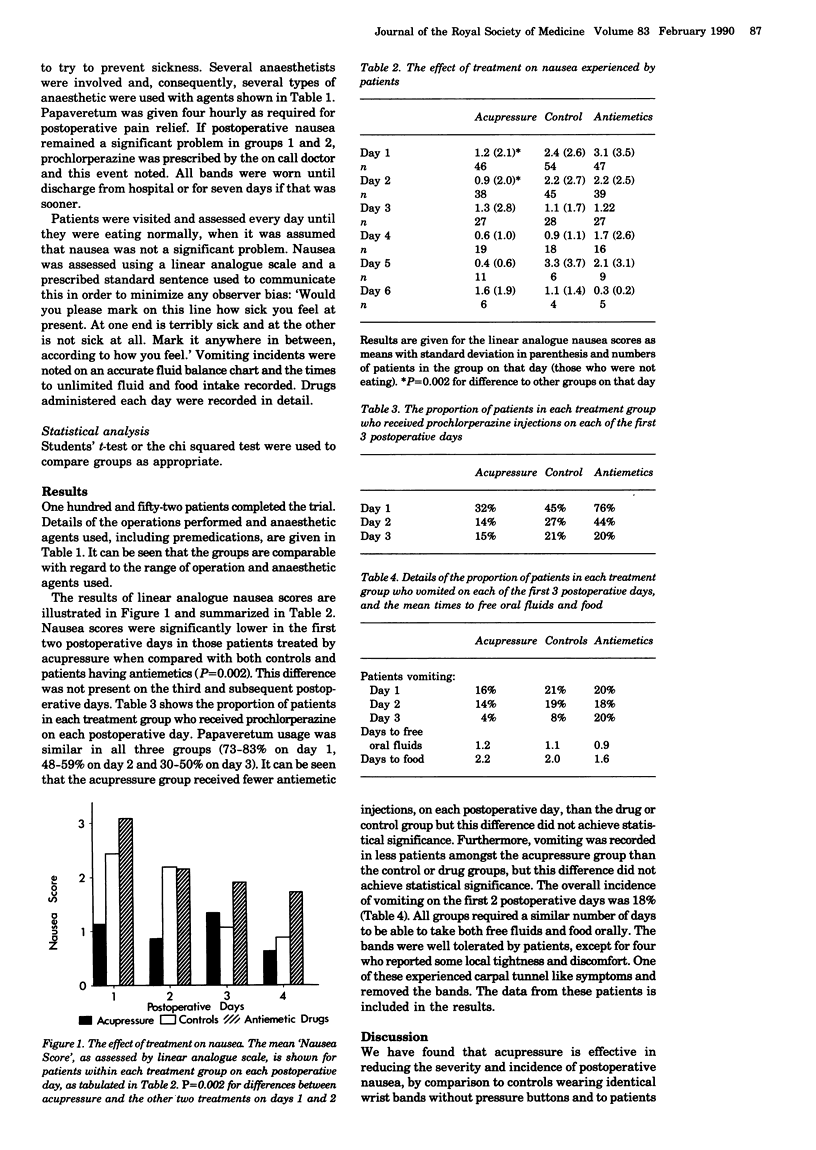Abstract
One hundred and sixty-two general surgical patients were prospectively randomized to one of three treatments for postoperative nausea and vomiting: (1) acupressure using elasticated bands containing a plastic button to apply sustained pressure at the P6 (Neiguan) point above the wrist, (2) control dummy bands without the pressure button and (3) antiemetic injections of prochlorperazine with each opiate given and as required. All patients received papaveretum injections as required for pain, and additional prochlorperazine injections were prescribed if nausea was not controlled in groups 1 and 2. The severity of nausea was assessed using a linear analogue scale and was significantly (P = 0.002) reduced by acupressure on both days 1 and 2, in comparison to both controls and drug treated patients. The incidence of postoperative vomiting, and the need for unplanned antiemetic injections was also reduced by acupressure but this was not statistically significant. Acupressure can work and should be investigated in other clinical situations.
Full text
PDF



Selected References
These references are in PubMed. This may not be the complete list of references from this article.
- ADRIANI J., SUMMERS F. W., ANTONY S. O. Is the prophylactic use of antiemetics in surgical patients justified? JAMA. 1961 Feb 25;175:666–671. doi: 10.1001/jama.1961.03040080022005. [DOI] [PubMed] [Google Scholar]
- DUNDEE J. W., MOOR J., CLARKE R. S. STUDIES OF DRUGS GIVEN BEFORE ANAESTHESIA. V. PETHIDINE 100 MG ALONE AND WITH ATROPINE OR HYOSCINE. Br J Anaesth. 1964 Nov;36:703–710. doi: 10.1093/bja/36.11.703. [DOI] [PubMed] [Google Scholar]
- Dundee J. W., Chestnutt W. N., Ghaly R. G., Lynas A. G. Traditional Chinese acupuncture: a potentially useful antiemetic? Br Med J (Clin Res Ed) 1986 Sep 6;293(6547):583–584. doi: 10.1136/bmj.293.6547.583. [DOI] [PMC free article] [PubMed] [Google Scholar]
- Dundee J. W., Ghaly R. G., Fitzpatrick K. T., Lynch G. A., Abram W. P. Acupuncture to prevent cisplatin-associated vomiting. Lancet. 1987 May 9;1(8541):1083–1083. doi: 10.1016/s0140-6736(87)90501-0. [DOI] [PubMed] [Google Scholar]
- Dundee J. W., Ghaly R. G., Fitzpatrick K. T., Lynch G., Abram P. Optimising antiemesis in cancer chemotherapy. Br Med J (Clin Res Ed) 1987 Jan 17;294(6565):179–179. doi: 10.1136/bmj.294.6565.179-b. [DOI] [PMC free article] [PubMed] [Google Scholar]
- Dundee J. W., Loan W. B., Morrison J. D. A comparison of the efficacy of cyclizine and perhenazine in reducing the emetic effects of morphine and pethidine. Br J Clin Pharmacol. 1975 Feb;2(1):81–85. doi: 10.1111/j.1365-2125.1975.tb00476.x. [DOI] [PMC free article] [PubMed] [Google Scholar]
- Dundee J. W., Sourial F. B., Ghaly R. G., Bell P. F. P6 acupressure reduces morning sickness. J R Soc Med. 1988 Aug;81(8):456–457. doi: 10.1177/014107688808100813. [DOI] [PMC free article] [PubMed] [Google Scholar]
- Fry E. N. Acupressure and postoperative vomiting. Anaesthesia. 1986 Jun;41(6):661–662. doi: 10.1111/j.1365-2044.1986.tb13083.x. [DOI] [PubMed] [Google Scholar]
- Millman B. S. Acupuncture: context and critique. Annu Rev Med. 1977;28:223–234. doi: 10.1146/annurev.me.28.020177.001255. [DOI] [PubMed] [Google Scholar]
- Prance S. E., Dresser A., Wood C., Fleming J., Aldridge D., Pietroni P. C. Research on traditional Chinese acupuncture--science or myth: a review. J R Soc Med. 1988 Oct;81(10):588–590. doi: 10.1177/014107688808101013. [DOI] [PMC free article] [PubMed] [Google Scholar]
- Vincent C. A., Richardson P. H. The evaluation of therapeutic acupuncture: concepts and methods. Pain. 1986 Jan;24(1):1–13. doi: 10.1016/0304-3959(86)90022-9. [DOI] [PubMed] [Google Scholar]
- Weightman W. M., Zacharias M., Herbison P. Traditional Chinese acupuncture as an antiemetic. Br Med J (Clin Res Ed) 1987 Nov 28;295(6610):1379–1380. doi: 10.1136/bmj.295.6610.1379. [DOI] [PMC free article] [PubMed] [Google Scholar]


